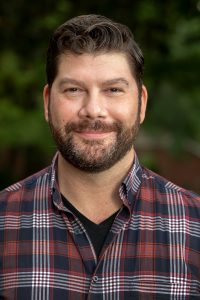Q&A with new faculty: Timothy Patrick

Timothy Patrick
Timothy Patrick is an observer by nature.
“I was always interested in my own thoughts and behaviors, as well as those of other people,” said Patrick, who has joined Randolph’s faculty as an assistant professor of psychology this year. “But when I took my first psychology course as a sophomore in college, I knew this was the area I wanted to pursue.”
Patrick received his B.A. in psychology from SUNY Oswego—about 15 minutes from where he grew up in Fulton, New York—before going on to earn his M.A. in experimental psychology from Cleveland State University and Ph.D. in cognitive psychology from Bowling Green State University.
Before coming to Randolph, he spent three years as a visiting assistant professor of psychology at Indiana University in Bloomington, Indiana.
This fall, Patrick is teaching Evolutionary Psychology during the first session of TAKE2 and Introductory Psychology and Research Methods during the second.
What attracted you to Randolph College?
“What drew me to Randolph was the sense of community and unity that you feel when you step on campus. You feel it in the hallways and in every interaction. There is a connectedness and an energy that is unique to Randolph. As soon as I experienced it, I knew this was the place for me.”
Describe your teaching style. What can students expect in your classes?
“My teaching style fully embraces the Socratic method. I aim to present information in a way that is intended to stimulate curiosity and critical thought. I refrain from telling my students what to think, but I encourage them to think in different ways and from different perspectives.
“My goal as an instructor is to harness the energy of the classroom by encouraging each student to both value and develop their own unique ways of thinking. This requires giving students some sense of ownership over the material they are exposed to. Students need to feel as if they are free to pursue their own relationship with the information. They need to feel liberated to ask questions, argue their points, and have a tangible impact on the thought processes of both their fellow classmates and myself. My goal is to spark the curiosity of each student, and to ultimately cultivate the synergy of the group.
“Students who take my classes should expect to be challenged to think about themselves and the world in new ways. I do everything I can to both educate and surprise my students with new and interesting information. In return, I encourage my students to be willing to examine their own thoughts and feelings and be willing to share the ideas that energize them the most.”
What are your initial impressions of Randolph and its students?
“So far, I find Randolph to be an extremely comfortable place to be. I genuinely feel like I am a part of the community here after such a short period of time, and I appreciate that more than I can fully express. To be honest, I was pretty nervous on my first day. I expected this nervousness to last a lot longer than it did. It’s been replaced almost entirely with excitement at this point. I owe this to the students. Their level of engagement in the class and their kindness outside of the class has made me feel right at home.”
What do you like to do outside of the classroom as far as hobbies or other activities?
“I try to play hockey as much as I can. Whether it be roller or ice, I absolutely love the sport and love playing. I also enjoy reading in my downtime. In the summer and fall, my wife and I go on lots of hikes, and we try to travel as much as we can and see new places. I also like to spend time with my two cats (Bob and Penelope), who have a visible love/hate relationship with each other.”

